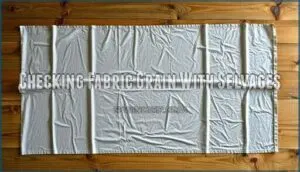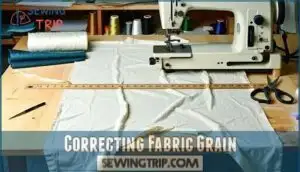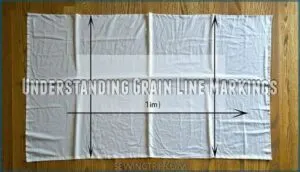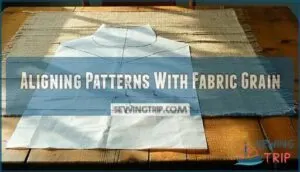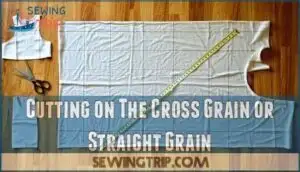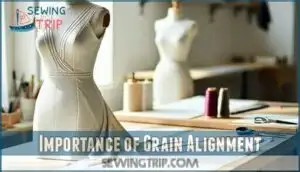This site is supported by our readers. We may earn a commission, at no cost to you, if you purchase through links.
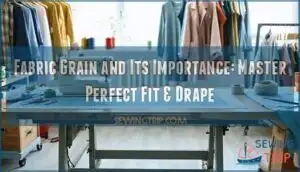
You’ve got three main types: lengthwise grain (strongest, runs parallel to selvage), crosswise grain (perpendicular to selvage), and bias grain (diagonal cut).
When you align your pattern pieces correctly with the fabric’s grain, your finished garment will hang properly, fit better, and move naturally with your body.
Cut off-grain, and you’ll end up with twisted seams, pulling fabric, and that homemade look that screams amateur hour.
The grain determines how your fabric drapes, stretches, and behaves—ignore it at your own peril, as understanding grain alignment separates sewists who create stunning pieces from those wondering why their clothes never quite look right, which is why it’s crucial to get it right to achieve a professional-looking result and avoid an amateurish appearance that lacks stunning pieces.
Table Of Contents
Key Takeaways
- You’ll master grain direction by identifying three types: lengthwise grain (parallel to selvage, strongest), crosswise grain (perpendicular to selvage, moderate stretch), and bias grain (45-degree angle, maximum stretch and drape).
- You’ll prevent garment disasters by cutting on-grain: proper grain alignment stops twisted seams, uneven hems, and that homemade look that screams amateur hour.
- You’ll achieve professional results by following pattern grainlines: those arrows on your pattern pieces aren’t suggestions—they’re your roadmap to garments that hang beautifully and fit as intended.
- You’ll save time and fabric by checking grain first: straighten off-grain fabric with steam ironing or diagonal stretching before cutting, and always fold fabric to verify alignment matches selvages perfectly.
Fabric Grain Basics
Understanding fabric grain is like learning the secret language of textiles—it’s the foundation that determines how your finished garment will fit, drape, and wear over time.
When you master fabric grain basics, you’ll transform from someone who fights with twisted seams and saggy hems into a sewer who creates professional-looking pieces that maintain their shape beautifully, utilizing the understanding of fabric grain to achieve a polished finish with proper fit.
Master fabric grain and watch your sewing transform from amateur disasters to professional perfection.
Definition of Fabric Grain
Fabric grain refers to the direction of warp and weft threads in woven fabric.
Think of it as your fabric’s roadmap – thread direction determines how your material behaves.
The lengthwise grain runs parallel to selvages following warp threads, while crosswise grain runs perpendicular following weft threads.
Bias grain sits at a 45-degree angle, offering maximum stretch.
Understanding grainline basics guarantees fabric stability and proper garment construction.
Types of Fabric Grain
When you’re working with fabric, you’ll encounter three main grain types.
Straight Grain runs parallel to the selvage, offering maximum stability with minimal stretch.
Cross Grain runs perpendicular to the selvage, providing moderate stretch compared to straight grain.
Bias Grain sits at a 45-degree angle, delivering the greatest stretch and drape.
Understanding grain behavior helps you choose the right grain direction for your project’s needs.
Different fabrics also possess unique characteristics, such as cotton’s exceptional breathability, which should be considered.
Importance of Fabric Grain in Sewing
Understanding grain direction makes the difference between professional-looking garments and homemade disasters.
When you cut fabric on the correct grain, your clothes hang beautifully and maintain their shape through countless wears.
Proper grainline alignment prevents twisted seams and wonky hems that scream "amateur hour."
Bias cutting benefits include enhanced drape for flowing silhouettes, while pattern matching becomes effortless when you respect the fabric’s natural structure.
Your garment durability depends on working with the grain rather than fighting it, and this approach allows for beautifully maintained clothes.
Identifying Fabric Grain
You’ll need to identify your fabric’s grain direction before cutting any pattern pieces.
Start by locating the selvages—those finished edges that run parallel to the strongest threads—or use simple tests like pulling threads and checking stretch to determine which way the grain runs.
This will help you understand the grain direction, which is crucial for the next steps.
Checking Fabric Grain With Selvages
Look for the selvages—those finished edges running parallel to the lengthwise grain.
They’re your fabric’s built-in guides for proper grain alignment. Check selvage texture and quality; they often feel different from the main fabric.
Fold your fabric with selvages matching perfectly. If they don’t line up, you’ve got an off-grain situation that needs fixing before cutting.
Using a Magnifying Glass to Identify Threads
When selvages aren’t available, grab a magnifying glass for Thread Magnification and Weave Clarity.
You’ll spot the difference between warp threads and weft threads through detailed Fiber Identification.
The magnified view reveals Grain Detail that’s invisible to naked eyes.
This Fabric Analysis technique helps you determine fabric grain direction by examining how woven fabric grain intersects.
To find the right tool, explore options for magnifying glass materials.
It’s like having x-ray vision for fabric threads!
Pulling a Crosswise Thread to Check Alignment
When you can’t spot the selvages, grab a crosswise thread and give it a gentle tug.
This thread-pulling accuracy method creates a straight line across your fabric, revealing any weave skew instantly.
Follow the pulled thread’s path and cut along it—this straight-line creation technique shows true fabric alignment.
If the line curves or wavers, you’re dealing with off-grain fabric that needs straightening before cutting to avoid distortion in your finished project.
Understanding the importance of fabric grain direction can greatly improve your sewing results.
Correcting Fabric Grain
When your fabric looks twisted or wavy after cutting, it’s likely off-grain and needs correction before you start sewing.
You can fix most grain problems using steam, gentle stretching, or proper folding techniques to get your fabric back in line.
Straightening Fabric With Steam Ironing
Steam ironing effectively straightens off-grain fabric when done correctly. You’ll need proper temperature control and moisture to realign those stubborn threads without causing damage.
Here’s your steam ironing roadmap:
- Set your iron to medium heat – High temps can scorch delicate fabrics
- Use distilled water – Prevents mineral buildup in your steam vents
- Work in sections – Iron small areas to maintain control over the process
- Apply gentle pressure – Let steam do the work, not brute force
- Check alignment frequently – Stop and fold to verify your progress
Choose steam settings based on fabric types – cotton handles more heat than synthetics.
Precise ironing requires consistent heat settings.
This ironing technique prevents distortion while preparing your fabric for cutting.
Regular equipment maintenance keeps your iron functioning properly, ensuring consistent results every time you tackle fabric grain issues.
Pulling Fabric Diagonally to Correct Grain
When steam ironing doesn’t fix your offgrain fabric, diagonal stretching offers another solution.
Gently pull the fabric’s short corner while holding the opposite corner steady. This fabric manipulation technique works best on natural fibers, though synthetic fabrics resist straightening.
Be mindful of distortion risks with printed patterns—excessive stretching can shift designs. For specialized tools, explore options for products for this technique.
Test diagonal stretching limits gradually, checking fabric grain alignment between pulls. Alternative methods include blocking damp fabric flat.
Folding Fabric to Check for Off-Grain Issues
After straightening your fabric, you’ll want to double-check your work by folding it properly to spot any lingering offgrain issues.
Fold the fabric lengthwise, bringing the selvages together—mismatched edges reveal stubborn alignment problems that need more diagonal stretching and careful ironing alignment.
Understanding the importance of grainline guarantees seam stability and prevents twisting.
- Selvage Test: Align selvages when folding; uneven edges indicate fabric orientation issues
- Corner Check: Square corners at the fold confirm proper fabric grain alignment
- Edge Inspection: Mismatched cut edges after folding reveal persistent offgrain problems
- Fraying Alignment: Pull threads along edges to verify fabric straightening success
Grain Line in Sewing Patterns
When you’re ready to cut your fabric, you’ll need to understand those mysterious arrows and lines printed on your sewing patterns – they’re called grainline markings, and they’re your roadmap to professional-looking results.
These markings tell you exactly how to position your pattern pieces on the fabric so your finished garment hangs properly and fits the way the designer intended, which is crucial for achieving professional-looking results and ensuring the garment is made according to the designer’s vision, with the finished garment hanging as intended.
Understanding Grain Line Markings
Once you’ve straightened your fabric, you’ll need to decode the pattern grainlines that guide your cutting.
Every sewing pattern includes a grainline arrow—a long straight line with arrows at both ends—printed on each pattern piece.
This grainline marking acts as your compass, showing exactly how to position pieces on your fabric.
Pattern grainlines guarantee matching markings align perfectly with your fabric’s straight grain.
When adjusting patterns or working with complex layouts, grainline accuracy becomes your best friend for professional results.
Aligning Patterns With Fabric Grain
Once you’ve identified pattern grainlines, proper alignment becomes your roadmap to professional results.
Pattern placement on woven fabric determines how your finished garment will hang, fit, and move.
The grainline arrow on pattern pieces shows exactly where to position them for grain accuracy.
Understanding fabric grainlines is essential for achieving the intended drape and elasticity.
Follow these alignment steps for perfect cutting on grain:
- Match the grainline arrow parallel to the selvage edge
- Measure equal distances from arrow ends to selvage
- Pin pattern pieces at both arrow ends first
- Double-check measurements before cutting
- Mark any bias cutting areas for special handling
This systematic approach prevents costly mistakes and guarantees your fabric grain works with your design intentions.
Cutting on The Cross Grain or Straight Grain
You’ll often choose between straight-grain and cross-grain cutting based on your project’s needs.
Straight-grain benefits include maximum stability and shape retention, while cross-grain advantages offer slight stretch and can save fabric.
When selecting grain direction, consider your pattern’s requirements and fabric waste concerns.
Some designs work beautifully cut on the crosswise grain, especially when you want controlled stretch or need to fit pattern pieces efficiently on your yardage.
Importance of Grain Alignment
When you cut fabric off-grain, you’re setting yourself up for a wardrobe malfunction that’ll have your seams twisting like a pretzel and your hems doing the wave.
Off-grain cutting turns perfect patterns into twisted disasters that’ll never hang right.
Proper grain alignment isn’t just sewing perfectionism—it’s the difference between a garment that fits like a dream and one that makes you look like you wrestled with your closet and lost.
Effects of Off-Grain Cutting on Garments
When you cut fabric off-grain, you’re setting yourself up for a world of wardrobe woes.
Your garments will develop twisted seams that spiral around your body, creating distorted fit that screams "homemade disaster."
Uneven hems become inevitable as the fabric pulls against its natural grain, while professional impact takes a nosedive.
This grainline importance extends beyond aesthetics—off-grain cutting compromises fabric stability, ruins fabric drape, and creates unpredictable fabric behavior that makes proper garment fitting nearly impossible, ultimately leading to fabric waste.
Manufacturer choices can lead to off-grain cutting to save costs.
Benefits of Proper Grain Alignment for Fit and Drape
When your fabric grain’s properly aligned, you’ll notice your garments hang naturally and maintain their intended silhouette.
Correct grainline importance becomes obvious through enhanced fit around curves like shoulders and hips.
Straight grain provides structure while cross grain offers comfort.
This fabric drape quality enables fluid movement, especially in bias-cut pieces.
Your fitted garments retain shape after laundering, while proper grain and drape create that professional finish designers use for specific aesthetic effects, including a natural silhouette and enhanced fit.
Industry Surveys on Grain Alignment and Fabric Drape
Research from major apparel manufacturers confirms that off-grain cutting directly impacts fabric drape and garment quality.
Industry surveys reveal that even minor grain misalignment during production leads to measurable drape deterioration and increased customer returns.
Statistical analysis shows manufacturers prioritizing grain alignment report 30% fewer fit complaints.
These findings establish clear industry standards linking proper textile grain understanding to superior fabric properties and commercial success.
Frequently Asked Questions (FAQs)
Why is fabric grain important?
Understanding grain direction determines how your fabric behaves—proper alignment prevents twisted seams, uneven hems, and warped garments.
You’ll achieve better fit, drape, and longevity when you respect the grain’s natural stability and stretch characteristics.
What can happen if the fabric is not on grain?
Like a house built on shifting sand, off-grain fabric wreaks havoc on your projects.
You’ll notice twisted seams, uneven hems, and garments that hang awkwardly.
The fabric stretches unpredictably, causing puckering and warping that worsens with each wash.
What is the importance of grain in fabric cutting and garment construction?
When you cut fabric correctly along its grain, you’ll guarantee your garments hang properly, maintain their shape, and resist stretching out of form over time.
How to tell which way the fabric grain is going?
Look for the selvage edges – they run parallel to the lengthwise grain.
Test fabric stretch; it stretches more across the width than lengthwise.
Pull a crosswise thread to reveal grain direction clearly.
Can fabric grain affect quilting block accuracy?
Yes, fabric grain substantially affects quilting block accuracy.
When you cut pieces off-grain, they’ll stretch and distort during sewing, causing blocks to lose their intended shape and size, making assembly difficult and creating uneven finished quilts, which is a result of the lack of consideration for quilting block accuracy.
Does preshrinking fabric change the grain alignment?
Preshrinking doesn’t change your fabric’s grain alignment—it just removes excess moisture and relaxes fibers.
However, if you’re not careful during the preshrinking process, aggressive handling can actually throw off-grain fabric further out of whack.
How does fabric grain impact embroidery distortion?
Like a compass needle finding true north, proper grain alignment prevents embroidery from pulling and puckering.
When you stitch against the grain, threads fight back, causing distortion, bunching, and uneven tension that’ll ruin your design’s crisp appearance.
Can you mix different grains in one project?
You can mix different grains in one project, but it’s tricky business.
Different grains behave differently when stretched, washed, and worn, which can cause puckering, twisting, or uneven hanging in your finished piece.
Does fabric grain matter for interfacing placement?
Don’t put the cart before the horse—interfacing grain absolutely matters!
You’ll want to align your interfacing’s grain with your fabric’s grain for ideal stability and drape, preventing unwanted stretching or distortion.
Conclusion
Remember, you reap what you sow—and in the context of fabric grain and its importance, proper attention to detail pays dividends in your finished garments.
You’ve learned that understanding grain types, identifying them correctly, and aligning your patterns properly makes the difference between professional-looking clothes and amateur attempts.
Don’t rush this fundamental step. Take time to check your fabric’s grain before cutting, and you’ll consistently create garments that fit beautifully and drape naturally every time.
- https://lindehobby.com/facts-about-fabric-grain-every-quilter-should-know-1694/
- https://blog.fabrics-store.com/2024/07/07/understanding-the-grain-of-fabric/
- https://interiorbstudio.com/the-three-types-of-fabric-grain-which-one-is-right-for-your-intimate-apparel/
- https://www.bradschultzdesign.com/post/fabric-grain-guide
- https://www.sussexseamstress.com/sewing-tips-blog/how-to-work-with-grain

